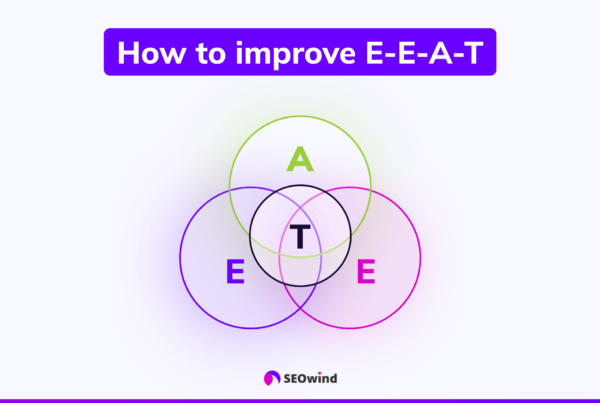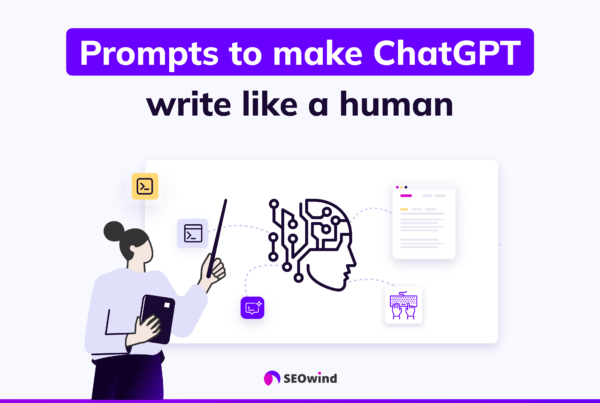The world of content creation is changing, with artificial intelligence becoming an increasingly powerful ally for writers and marketers. But contrary to popular belief, AI isn’t a magic bullet that instantly produces publish-ready content. Instead, it’s a sophisticated co-pilot that requires strategic guidance and human expertise to reach its full potential.
In this guide, we’ll explore practical AI writing tips that will help you deliver real results. From research fundamentals to prompting techniques, editing workflows to SEO optimization, you’ll discover how to use AI’s capabilities while maintaining the human touch that makes content truly exceptional.
Understanding AI Writing: It’s a System, Not a Magic Bullet
The biggest mistake content creators make is treating AI as an automated replacement for human writers. That’s not how it works. Writing with AI is a multi-step process that blends automation with human expertise, what we might call the “CyborgMethod™”, where AI serves as your co-pilot, not your autopilot.
“AI writing isn’t a one-click solution,” explains Tom Winter, CGO at SEOwind.io. “It’s a system that requires structure, deliberate planning, and collaboration. AI enhances your workflow, but it never replaces the strategic thinking and nuance only a human can bring.”
Recent statistics highlight this reality: while over 85% of AI users report using AI primarily for content creation, successful implementation requires a systematic approach. This approach involves three critical phases:
- Research and preparation
- Strategic prompting
- Human refinement and optimization
Let me share with you a couple of AI writing tips and tricks to maximize results while maintaining quality.
Tip 1: Keep foundation in mind: Garbage In, Garbage Out
The famous computer phrase “garbage in, garbage out” applies to AI content writing tips. Essentially, this adage highlights the importance of providing quality input to the AI-based tools you use to write content. In return, these tools will give you outstanding output that matches your standards and expectations. Incorporating this understanding into your content creation process can help improve your end product and make it more valuable for your audience.
Understand Your Input Data’s Significance
It’s essential to understand the significance of the input data you provide:
- The text samples from an AI tool should be relevant and coherent to ensure accurate results.
- Ensure the data is up-to-date.
- Make efforts to supply error-free inputs since even minor mistakes could lead to misunderstandings or errors in AI-generated outputs.
Realizing how crucial input data is during content generation will allow you to effectively produce high-quality AI output.
Continuously Refine Your Input Data
Don’t forget the importance of refining your input data when following ai copywriting tips:
- Eliminate irrelevant or low-quality source materials before feeding them into an AI-powered application.
- Regularly update any datasets or text samples used by these applications, ensuring they continue producing fresh and enlightening material instead of regurgitating outdated or overused information.
- Analyze feedback from clients and peers; implement valuable insights by revising your inputs accordingly.
Be Specific in Your Prompts

Michael Alexis, CEO, tiny campfire
AI is only as good as the humans who are writing it. Many people complain about the generic nature of AI writing, but bland writing is often the result of a too-broad prompt.
You should be as specific as possible in your instructions to the AI software. For example, instead of typing “write a paragraph about employee engagement,” command “write a paragraph about remote employee engagement from the perspective of a small business CEO.”
Also, tinker with your AI tools settings to find the optimal tone and composition for your brand. Once you find a prompt style that works well, you can even automate a tool with these settings to generate content even faster.
Embrace AI Technology Wisely
Remember, when incorporating artificial intelligence into your creative process, you shouldn’t hand all tasks or decisions to AI technologies. While these tools offer incredible support, human oversight remains vital for exceptional output.
Some activities where you should rely on your instincts and expertise include:
- Establishing the overall tone and voice of the content.
- Adding any personal experiences or insights.
- Applying any specific writing tips and tricks unique to your industry.
Balancing the skillset offered by AI applications with your abilities is an essential aspect of creative content generation—one that requires constant attention and fine-tuning.
Tip 2: Do the research first

Tom Winter, CGO, SEOwind.io
Don’t skip the research! Conducting SERP analysis, content, and keyword research is vital for understanding your audience’s needs and interests. This ensures your content effectively addresses their specific demands.
When using AI-powered content generation tools, providing a comprehensive content outline and researched keywords is crucial. This enables the AI to generate coherent, accurate, and contextually-rich content. The more context you provide, the better the AI mimics human-like writing and delivers valuable information.

Tip 3: Harness AI Creativity by Re-prompting

Robert Wolski, Co-founder, Halftone Digital
By utilizing re-prompting, you can refine and expand upon AI-generated content, unlocking the full potential of your writing and ensuring it aligns with your unique brand voice and goals.
You can use re-prompting effectively in your AI-assisted content marketing efforts. Begin by giving the AI a clear and concise prompt, outlining your topic and any specific instructions or requirements.
Tip 4: Options Are Your Friend
As a content writer, having plentiful options is critical when crafting compelling and attractive material. By integrating AI-powered tools and embracing various techniques, you can expand your writing capabilities to carry both versatilities and ensure that your content remains fresh and engaging.
Here are some AI content writing tips to help you explore and take advantage of the diverse alternatives available to you:
Generate New Ideas for Your Content

Luciano Colos, Founder and CEO, PitchGrade
By using AI in your content marketing strategy, you can save time and resources while also improving the quality and effectiveness of your content.
By using AI tools like ChatGPT, you can quickly generate many potential topics and ideas based on your target audience and keywords.
This can help you come up with fresh and unique content ideas that your competitors may not have thought of. You can use AI to improve the overall quality of your content. For example, AI tools can help you with grammar and spelling checks, suggest better word choices, and even help you optimize your content for search engines.
Utilize AI-Powered Writing Tools
Harness the power of artificial intelligence by incorporating a range of advanced tools into your workflow. Such applications can assist with tasks like generating content ideas, enhancing phrasing, correcting grammar, or evaluating the readability of your text. Some popular options include Grammarly for proofreading, SEOwind for content research and AI writing, and Hemingway Editor for refining sentence structure.
Experiment with Content Formats
Delving into different formats can be incredibly beneficial when seeking to elevate the appeal of your work. Not only will this expose new creative possibilities, but it will allow for catering appropriately to the preferences of varied audiences. Some examples of formats that could add interest to your written pieces include:
- List-based articles
- Case studies
- Infographics
- Interactive quizzes
- Interviews and Q&As
Explore Different Writing Styles
Diversifying your approach in terms of writing style is another excellent way to keep readers engaged. Demonstrating flexibility within various types showcases adaptability and skill while also enabling the tailoring of more suitable material toward specific target groups. To broaden stylistic horizons:
- Study numerous writers with distinct voices; become observant in understanding their use of language.
- Embrace trial-and-error through experimentation: break out beyond standard comfort zones by venturing into unconventional territories.
- Seek feedback from peers, mentors, or industry professionals who could offer insight on honing unique styles.
Remember that using multiple frameworks is essential when striving for captivating content creation backed by AI-supported tools and approaches. Cultivating an understanding of the relevance of each option will aid in selecting the most appropriate match for any given situation. By exploring and embracing this wide array of possibilities, you can ensure that your creative abilities flourish while staying ahead within the ever-changing content production landscape.
Tip 5: Ask Questions in The Appropriate Context

Alli Hill, Founder and Director, Fleurish Freelance
One thing AI tools (like ChatGPT) do well that Google can’t do is understand queries within a specific context. There’s more leeway when entering questions and information so that ChatGPT can understand what you’re asking and why you want to know. You can add “… in the context of…” to your queries to generate more appropriate responses, which can streamline the research process.
AI tools are great for quickly synthesizing information that would take much longer to uncover on Google. You won’t get perfect responses, but starting here can be a great way to save time on research and know how to apply it to your specific topic or use case.
Tip 6: Provide Unique Perspectives and New Information
One crucial aspect of producing unique content is offering distinctive insights and new information on any topic. This becomes even more vital when you produce content using AI tools as they rely heavily on input data to generate output. To ensure success in developing value-adding content marketing with AI:
- Dig deeper: As tempting as it may be to scratch the surface on popular subjects, challenge yourself to uncover lesser-known facets or angles of a topic. By providing exclusive viewpoints, you’ll foster curiosity among readers.
- Research extensively: Invest time combing through various resources like authoritative websites, expert opinions or interviews, industry reports, or whitepapers before crafting your piece using AI writing tools. This way, you’re confident that your input database and argument foundations are solid.
- Employ critical thinking: With access to a treasure trove of data resources at our fingertips nowadays, ensure you question sources discerningly and continually reevaluate theories throughout your research process.
- Blend human input with AI ideas: Use creative prompts generated by machine learning algorithms while penning down original thoughts inspired by what you’ve discovered during your research process.
By committing yourself to exceptional research and relentless inquiry infused with creativity from artificial intelligence suggestions, you’ll be well-equipped to deliver genuinely original content and unique perspectives for hungry audiences—standing out amidst mediocrity.
Remember that the end goal is to create content that offers value, engages readers, improves authority, and builds trust. Combining human expertise with AI augments our work, allowing us to unlock uncharted territories in content creation.

Tip 7: Write for Your Target Audience
One of the cornerstones of successful content writing is tailoring your work to suit your target audience’s interests, preferences, and knowledge levels. Knowing whom you speak to will help captivate their attention and foster trust and credibility. Here are some AI content writing tips that focus on addressing audience-specific requirements:
Align your topic with your reader’s interests
Understanding what intrigues or concerns your readers is vital in establishing a meaningful connection with them. Make sure to:
- Conduct thorough research on the preferences and needs of your audience.
- Keep abreast with industry trends and news.
- Analyze which articles resonate most with your readers by monitoring engagement metrics.
Speak their language
Your choice of vocabulary and tone should resonate well with the intended audience. To accomplish this:
- Identify demographic information such as age, education level, profession, and cultural background.
- Use jargon selectively – while experts within specific fields might understand technical terms, they might alienate others.
- Match the formality or informality based on the general conversational style prevalent amongst your readers.
- Address individual pain points.
Your content should offer solutions or insights that directly speak to personal hurdles faced by your audience members:
- Pinpoint common problems or concerns expressed by those within relevant user groups, forums, or social media platforms.
- Center your content around offering practical guidance or solutions.
- Share real-life examples highlighting how specific methods have helped overcome similar obstacles.
Cater to various learning styles.
Bear in mind that individuals process information differently; hence it’s crucial to accommodating these differences through diverse types of content presentation:
- Combine text with visuals, including images, infographics, diagrams, or flowcharts.
- Break down complex concepts into snackable sections using bullet points or numbered lists.
- Incorporate anecdotes or case studies to engage storytelling enthusiasts.
As you blend AI-powered tools with your content writing process, remember that these technologies are meant to enhance and fine-tune your hard work, not replace the human touch. By understanding and catering to the needs of your audience, you maintain a solid connection and increase the likelihood of converting passive readers into active supporters.
Tip 8: Fact-Check Your AI Writing
The rise of AI-powered content generators has made the process of content and article creation faster lot cheaper, and more efficient. However, ensuring that your AI output is factual and accurate is essential. Here are some AI content writing tips to help you fact-check your articles for credibility and reliability:
- Verify information from multiple sources: Cross-referencing information from different sources helps establish the validity of a statement or claim in your content. Incorporating diverse viewpoints will enhance the quality of your work and improve its credibility.
- Cite reputable sources: To establish trust with your audience, cite reliable, authoritative sources when presenting data or research findings. This practice demonstrates respect for intellectual property rights and adherence to ethical standards in content writing.
- Stay up-to-date: It can be challenging to keep abreast of developments in various fields. However, staying current with recent studies, news articles, and emerging trends is crucial in maintaining accuracy within your work.
- Avoid misleading statements: Carefully consider phrasing before making definitive statements about statistics or research data—hyperbolic language may unintentionally convey false or incomplete information.
Remember that while AI and other tools can assist immensely in generating high-quality, long-form content quickly, fact-checking remains primarily a human writer’s responsibility. Stay vigilant during the editing process by double-checking all claims against reputable sources. This diligence will set you apart as a true professional in content writing.
Tip 9: Choose Patterns for Your Writing
When using an AI writing tool, experiment with different patterns or templates until you find ones that suit your specific needs:
- Experiment with various text structures, such as listicles, how-to guides, and long-form content – some may work better than others for specific topics.
- Consider incorporating popular writing styles like conversational or storytelling tones – they can make your content more engaging.
Tip 10: Use the Power of Storytelling
Storytelling is one of your most powerful tools as a content writer. People naturally connect with stories, allowing them to comprehend better and retain information. By incorporating storytelling into your AI-driven writing processes, you can create meaningful relationships with your audience while maximizing the likelihood that they will engage with the content you write.
Engage Your Readers Emotionally
One of the core principles behind storytelling is evoking emotions in your readers. A compelling narrative can grab attention, maintain it, and leave a lasting impression on those interacting. Consider these AI content writing tips for including emotion in your writing:
- Illustrate relatable experiences by touching upon common pains, desires, or everyday situations.
- Build tension through conflict, challenges, or choices that need to be made.
- Evoke empathy by presenting authentic characters with flaws and strengths similar to what real people possess.
Emphasizing emotions in your pieces allows for deeper connections between reader and writer – a crucial element for fostering engagement.
Use Analogies and Metaphors
Analogies and metaphors can simplify complex concepts while enhancing creativity in your writing. These comparisons enable people to grasp new ideas by employing familiar references, making the material more digestible for various audiences. Here are some writing tips and tricks revolving around analogies and metaphors:
- Select relevant comparisons: The metaphor or analogy must resonate with readers so that they can understand its intended meaning.
- Use comparisons sparingly: Employing too many analogies or metaphors might make blog post or article appear convoluted; balance is essential.
Integrating these techniques adds depth to AI-generated text while maintaining clarity for inexperienced audiences.
Paint Vivid Imagery
The art of painting vivid imagery requires a careful selection of words to convey imaginative visualizations throughout your storylines. Humans are visually oriented, meaning descriptive language can trigger images in their minds, immersing them in the content. Consider these points when adding visual aspects:
- Be specific: Vague descriptions may confuse and leave readers detached from your narrative.
- Opt for sensory language: Sight, sound, smell, touch, and taste are essential to creating immersive experiences.
Craft Compelling Characters
The backbone of any memorable story lies within its characters. Well-developed personas evoke emotions that drive reader investment into what transpires throughout your piece. Creating and incorporating compelling characters helps readers quickly identify with your message, fostering more robust connections. Keep these guidelines in mind:
- Develop multi-dimensional characters: Give each character a unique voice, motivation, or quirks that make them relatable.
- Ensure believability: Even fictional characters must remain plausible enough for audiences to connect with them emotionally.
Elevating your storytelling skills is more about refining human-centric techniques than adopting AI capabilities. Applying these AI content writing tips aids writers in crafting narratives that resonate on an emotional level – achieving higher levels of audience satisfaction overall.
Tip 11: Apply SEO Best Practices
As a content writer, you’re not just writing for your readers but also for search engines whose algorithms have the responsibility to rank your content among all available results online. You can ensure that your piece effectively reaches your intended audience by employing AI content writing tips and following SEO best practices.
Research Targeted Keywords
One of the essential elements of SEO is keyword research. Identifying and selecting relevant keywords will allow search engines to understand the purpose of your content and display it to users actively searching for information in that domain. Tools like Google Keyword Planner or SEMRush are valuable assets for discovering popular search terms related to your niche.
Incorporate Key Phrases Naturally
Once you’ve chosen suitable keywords, integrate them into your article seamlessly without making the inclusion feel forced. Use long-tail variations as well — they might attract lesser traffic but are generally less competitive and more targeted. Remember that overstuffing keywords may lead to penalties from Google under their guidelines regarding gaming search rankings artificially.
Use LSI Terms
Latent Semantic Indexing (LSI) refers to using synonyms or contextually related words instead of solely relying on exact-match keywords. This method helps establish semantic relationships between topics within a body of text, further enhancing the relevance of the content according to search engine algorithms.
Optimize Meta Descriptions and Headings
Meta descriptions summarize your post’s contents and play a significant role in persuading searchers to click through from search results pages. Writing an enticing meta description that contains target keywords is crucial for higher click-through rates. Optimizing headings and product descriptions by integrating searched terms increases readability and opportunities for better ranking.
Make Use of Internal Links
Linking internally throughout your website can enhance visitors’ navigation experiences while simultaneously generating positive signals for search engines’ algorithms — improving overall site ranking abilities.
By incorporating these SEO best practices and using AI content writing tips as a supplement to your writing process, you will increase the visibility of your work while preserving intelligibility and authority. Remember, maintaining a balance between catering to search engines and engaging readers is crucial for success in content creation.
Tip 12: Include Your Brand Voice and Tone
While AI writing tools have come a long way in automatically identifying tone and voice preferences, they might still need to catch up when capturing your brand’s unique personality. To maintain consistency across all communications, make sure to apply your brand’s voice and tone throughout the generated content:
- Review your company style guide for guidance on using the correct voice and tone.
- Make any necessary modifications to the final text to align with your established standards.
Tip 13: Edit Like a Pro and Be Ready to Adapt

Temmo Kinoshita, Co-founder, Lindenwood Marketing
In my marketing agency, I’ve found that careful editing is the key to success when using AI for content marketing. AI writing is getting quite good, but the human touch is still necessary to make unique content. I follow a 90/10 rule: I let AI get my content 90% of the way there, but I put in a little extra human effort to finish that final 10%. That little extra polish really helps my content stand out.
Enhance Readability
Keeping AI-generated content easy to read is critical to retain and keep readers engaged throughout the article. Implement these readability-enhancing techniques:
- Break down complex sentences into shorter, simpler ones.
- Use headings and subheadings to organize your text into digestible chunks of information.
- Utilize bullet points or numbered lists where appropriate, making vital insights stand out.
- Add meaningful graphics or visuals if needed to break up blocks of text.
Embrace the Editing Process
As content writers, we must accept that editing is integral to using AI writing software. To sharpen your AI content writing skills, approach editing as an opportunity rather than a burden. Here are some tips and tricks to help you edit effectively:
- Be thorough: Review your work several times, focusing on grammar, structure, flow, or keyword usage.
- Take breaks: Step away from your work during editing to gain fresh perspectives.
- Ask for feedback: Having another individual read and critique your writing can be invaluable in identifying errors or areas for improvement.
Get Familiar with AI Writing Software
Artificial intelligence has made significant advancements in recent years, making it easier than ever to improve your writing. Utilize these AI writing tools to enhance and streamline your editing process:
- Grammar checkers: Tools like Grammarly offer real-time feedback regarding grammar and punctuation errors.
- Readability analyzers: Hemingway Editor evaluates the readability of your text based on word choice and sentence length.
- Plagiarism detectors: Ensure originality by using programs like Copyscape or Unicheck.
These AI-driven resources save time and facilitate more polished and professional content.
Adaptation Is Key
In the world of content writing—especially when incorporating AI—adaptation is crucial for staying ahead of industry changes:
- Stay updated on SEO trends: Regularly researching SEO best practices will ensure optimal visibility for you and your clients.
- Learn new software: As technology advances, so should our knowledge of available tools like natural language generators or machine learning platforms.
- Don’t resist change: New techniques may lead to uncomfortable transitions initially; however, embrace them wholeheartedly for continuous growth as a writer.
Ultimately, editing is vital for refining your craft and generating successful content. Incorporating AI assistance, staying adaptable, and being willing to learn about advancements in the field will elevate your skills as a professional writer. Embracing this ever-changing world can increase efficiency and accuracy and lead to unique, inspiring work. Always be open to adapting alongside technology because it may introduce you to techniques you never imagined possible.
Tip 14: The Human Touch in Content Writing Still Matters
As AI continues to disrupt various industries, it’s essential to remember the value of the human touch when creating content. While artificial intelligence can automate certain aspects of the process, there are fundamental elements that only a human writer can deliver effectively. These include engaging storytelling, empathy, cultural sensitivity, and an understanding of the subtle nuances of language.
Emotional Connection
One significant factor that sets human-written content apart from machine-generated text is our ability to evoke emotions through storytelling. This skill enables us to resonate emotionally with readers and create a more potent connection. AI cannot feel genuine emotions or forge relationships as humans do. Hence, it can easily tap into these vital attributes with assistance from a skilled content creator.
Cultural Sensitivity
Another crucial aspect distinguishing human writers from AI writing tools is our capacity for cultural understanding. As a writer, you have been exposed to diverse cultures, which give you insights into how language usage varies across different regions and demographics. It allows you to tailor your writing for specific audiences with unique preferences without offending or alienating them unintentionally. On the other hand, AI might need help to detect these nuances limiting its adaptability across various contexts.
Creativity and Fluidity
When crafting compelling content, creativity is essential – something that human writers possess in abundance. Still, AI needs to improve significantly at this stage of technological advancement. Although algorithms can write acceptable content based on pre-programmed parameters, they cannot rival the imaginative prowess of their human counterparts when producing thought-provoking ideas and captivating prose.
Additionally, language is fluid by nature; we often come up with new expressions or idioms to suit changing times and circumstances. An agile approach towards words remains unparalleled among even the most innovative AI applications reliant on existing data for sentence formation.
Incorporate the following tips to maintain a human touch in your content:
- Inject personal experience or unique insights into your writing.
- Show empathy for your readers’ emotions, feelings, and experiences.
- Be conscious of cultural references and their implications.
- Infuse creativity with relatable analogies, examples, or comparisons.
By integrating these techniques into your ai content writing tips and striking the right balance between artificial intelligence assistance and authentic human expression, you’ll create compelling and evocative articles that attract and retain reader interest while propelling your content marketing strategy to unprecedented heights.
Tip 15: Avoid Plagiarism
Avoiding plagiarism plays a crucial role in maintaining the credibility and integrity of your work. Implementing proper fact-checking methods and adhering to anti-plagiarism practices can help you avoid potentially damaging consequences. Here are some ai content writing tips to assist you in these efforts.
Thoroughly Research Your Subject Matter
Before diving into the writing process, invest time and effort into comprehensively researching your topic. Familiarize yourself with multiple sources, including books, research papers, blog posts, news articles, and discussions by industry experts. A well-researched piece strengthens your authority as a writer. It helps ensure that you present accurate information to your readers.
Safeguard Against Plagiarism
Proactively preventing plagiarism is crucial in maintaining your professionalism as a content writer. Here are a few tips on some writing tips and tricks to help maintain originality.
- Paraphrase: When absorbing information from multiple sources, express the content using your unique voice and style. Transforming the structure and language of borrowed concepts can reduce the risk of accidental plagiarism.
- Cite Your Sources: Always attribute any direct quotes or specific ideas from other materials. Prominently acknowledge the original authors by following accepted citation practices in your industry or chosen niche.
- Utilize Plagiarism Checker Tools: Numerous platforms like Grammarly, Turnitin, or CopyScape offer specialized tools that detect plagiarized content. Deploy these tools to verify that you present an original piece before submission.
Applying these fact-checking techniques and anti-plagiarism measures will serve as invaluable ai content-writing tips for generating reputable work within the industry, ultimately enhancing your credibility as a reliable professional.
Common Mistakes to Avoid When Using AI Writing Tools
AI writing tools have gained popularity as a means to generate content quickly and efficiently. However, using these powerful technologies is not without its pitfalls. Be aware of common mistakes that people often make when employing these cutting-edge tools. Here are two critical missteps to keep in mind:
Poorly crafted prompts
One fundamental principle in computer programming is “garbage in, garbage out,” emphasizing the importance of quality input for obtaining valuable output. This principle holds just as accurately for AI writing tools.
- To produce great content, provide clear, concise, and accurate information when preparing prompts or guidelines.
- Avoid ambiguous instructions or vague topics: precise instructions enable the AI writer to create targeted content that aligns with your goals.
- Feeding the wrong keywords or insufficient details can result in subpar output, irrelevant information, or off-topic material.
By carefully crafting your input and refining your briefs, you can significantly improve the outcome produced by your chosen AI writing software or tool.
Overly Technical Terms & Jargon
Another common mistake individuals make utilizing AI writing tools involves heavy reliance on technical terms or industry-specific jargon without providing sufficient context or explanation. While it may be essential to demonstrate expertise within a given subject matter, overly complicated language can alienate readers—especially if they lack familiarity with those terms.
To mitigate this issue:
- Choose simple words and accessible phrases whenever possible; remember that clarity should always precede complexity.
- Consider incorporating precise explanations for any technical concepts introduced—both for your human audience’s benefit and as additional guidance for the AI tool itself.
- Monitor AI-generated content closely to identify instances with overly technical language; edit these sections accordingly before publishing.
- Encourage feedback from readers or colleagues, which can provide valuable insights and help fine-tune your AI tool’s output.
By balancing technical accuracy and linguistic simplicity, you can ensure that your AI-generated content effectively communicates essential information to a wide spectrum of users—ultimately fostering broader understanding and engagement.
Google’s Current Stance on AI Content
Google has significantly evolved its position on AI-generated content, focusing now on quality and value rather than how content is created. According to Google’s latest guidance:
- Quality Over Origin: Whether content is AI-generated or human-written is less important than its helpfulness and value to readers
- People-First Content: Content must be created primarily to help users, not to manipulate search rankings
- Transparency: Websites should disclose when AI was substantially involved in content creation
- E-E-A-T Standards Apply: Experience, Expertise, Authoritativeness, and Trustworthiness remain critical factors
To meet Google’s standards, ensure your AI-assisted content:
- Provides unique insights or information
- Demonstrates subject-matter expertise
- Includes proper attribution for sources and facts
- Offers genuine value beyond what’s readily available elsewhere
- Maintains transparency about AI involvement when appropriate
Comparing Popular AI Writing Tools
Different AI writing tools offer unique strengths and weaknesses. Here’s how some of the most popular options compare:
ChatGPT (OpenAI)
- Strengths: Versatile, excellent at following complex instructions, strong contextual understanding
- Weaknesses: Limited knowledge cutoff, occasional factual errors, no built-in research capabilities
- Best for: General content creation, brainstorming, outlining, rewriting
Claude (Anthropic)
- Strengths: Longer context window, nuanced responses, excellent at understanding nuance
- Weaknesses: Sometimes less assertive than competitors, more conservative outputs
- Best for: Long-form content, complex reasoning tasks, sensitive topics
Jasper
- Strengths: Marketing-focused templates, brand voice settings, team collaboration features
- Weaknesses: Higher cost, sometimes repetitive outputs
- Best for: Marketing teams, agencies, dedicated content operations
SEOwind
- Strengths: Built-in SEO research, SERP analysis, content briefs integration
- Weaknesses: More specialized than general-purpose AI tools
- Best for: SEO-driven content creation, comprehensive research workflows

Recent statistics show that ChatGPT is the most trusted AI tool for writing with a 77.9% selection rate, outpacing the nearest competitor by more than 50%. Multiple competitors reference the “rule of 50/50” for optimal results: writing half the content yourself and using AI to complete or enhance the other half.
AI vs. Human Writing: A Decision Framework
To help determine when to use AI versus human writing, consider this practical decision framework:
| Content Element | AI-First Approach | Human-First Approach |
|---|---|---|
| Research & Data Collection | ❌ Limited accuracy | ✅ Critical thinking & evaluation |
| Initial Drafts | ✅ Fast generation | ❌ Time-intensive |
| Technical/Factual Content | ❌ Requires verification | ✅ Accurate when knowledgeable |
| Personal Narratives | ❌ Cannot create authentic experiences | ✅ Genuine and authentic |
| Ideation & Outlines | ✅ Quick generation of options | ✅ Creative connections |
| Summarization | ✅ Efficient condensing | ✅ Identifying true importance |
| Emotional/Persuasive Content | ❌ Can feel inauthentic | ✅ Natural emotional resonance |
When to prioritize AI:
- When speed is essential
- For repetitive, formulaic content
- When generating multiple variations
- For initial drafts and outlines
- When summarizing large volumes of text
When to prioritize human writing:
- For thought leadership
- When building emotional connections
- For complex, nuanced topics
- When sharing personal experiences
- For high-stakes content (sales pages, legal documents)
The future of content creation isn’t purely AI or purely human – it’s collaborative. With 48% of businesses now using some type of machine learning or AI across their operations, finding the optimal human-AI workflow is becoming essential for competitive content teams.
By integrating these AI content writing tips into your workflow, you can significantly enhance productivity without sacrificing quality. Remember that AI is a powerful tool, but the strategy, creativity, and human connection that make content truly effective remain firmly in human hands.


